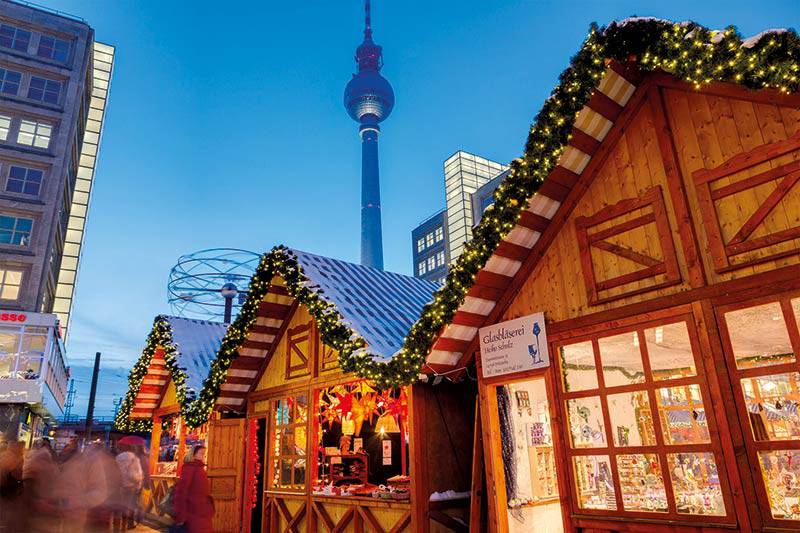With more than 60 Christmas markets, Berlin was the obvious choice for a festive break.
In recent years, the ‘traditional German market’ has been adapted here -UK towns and cities boast wooden chalets proffering sausages, beer and crafts. And while these are charming, for the real deal there’s nothing better than Berlin.
Here, we’ve had a mild winter thus far, but landing in Berlin to a flurry of snow helps create festive cheer (even if I do wish I’d packed warmer clothing).
Having found our hotel, near Alexanderplatz, and thawed, we set off for our first market. Metres away, we discover the wonderful Berliner Weihnachtszeit at Roten Rathaus. One of the oldest Christmas markets in Berlin, this is exactly what we’re after.
Traditional stalls sell everything from unusual food to wooden gifts. We stop to pet ponies in a stable, then order our first Gluhwein (mulled wine) and retire to watch the ice skaters. A few sips later, a marriage proposal occurs on the ice, followed by another flurry of snow and a blast of Silent Night. I’m not sure whether it’s the wine, the fire or the betrothed couple, but in a few hours, Berlin has worked its Christmas magic on me.
We wander on to the Alexanderplatz market. Surrounded by department stores and with the TV tower looming above, you’re reminded you’re in a city. The lights are brighter, the stalls busier and there are definitely more tourists.
Every day more than 300,000 people visit the square, so this market is one of the go-to destinations for anyone seeking Christmas cheer. While it’s less traditional than the first market, it’s certainly atmospheric, and I can confirm the currywurst is delicious.
Not far away is Wintertraum am Alexa, another experience entirely. Not dissimilar to Hyde Park’s Winter Wonderland, this area is packed with illuminations, rides and entertainment. We stay for another gluhwein (when in Berlin…), but if you’re visiting with children, this market is a must.
The next day, we visit the Weihnachtszauber at the Gendarmenmarkt. This is one of Berlin’s most popular markets, and it lives up to expectations. As well as an abundance of wooden huts, there’s a warm and welcoming indoor market space.
While the markets are fantastic during the day, they’re at their most magical by night, so we pay an evening visit to Charlottenburg Palace. It isn’t the biggest market, but certainly one of the most atmospheric. With the palace illuminated and fairy lights twinkling through the trees, it’s easy to get in the festive spirit. When we discover the gluhwein is served in boot-shaped mugs, we order, and waive our deposit so we can take the mugs home.
You might think that three days in, we’d tire of bratwurst and mulled drinks, but no – we travel to the Spandau market, in the largest pedestrianised zone in the city. As well as rides and entertainment for children, much of this market is traditional – at the entrance we’re greeted by a 40ft long stollen cake, and there’s a medieval quarter with singing, dancing and handmade gifts.
Perhaps my favourite element is Spandau’s food offerings, which include the half-metre wurst. Sadly, they halve it to fit it in the roll, but still, nothing will warm you up like 50cm of sausage and a warm cherry beer.
Of course, Berlin has a huge array of excellent eateries with 20 boasting at least one Michelin star, but really, for a Christmas break, the markets have all you need to keep you fed and watered. Unless you actually want water, in which case it’s harder to come by.
We leave Berlin feeling rounder than St Nicholas and having only seen ten per cent of the Christmas markets, but keen to return and explore more of this vibrant place. And of course, come back with emptier bags, for some more of those gluhwein mugs…








